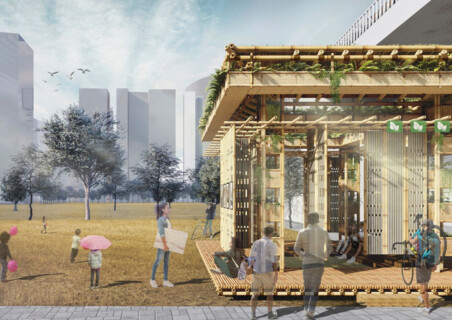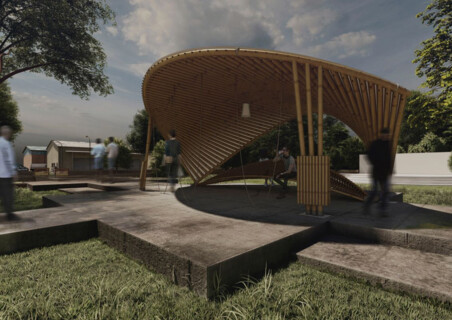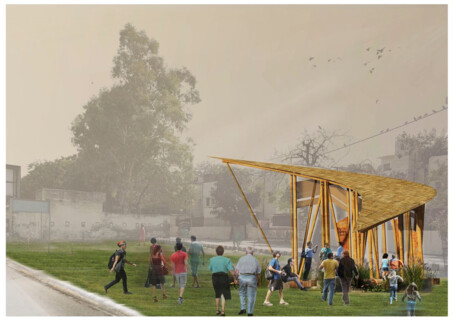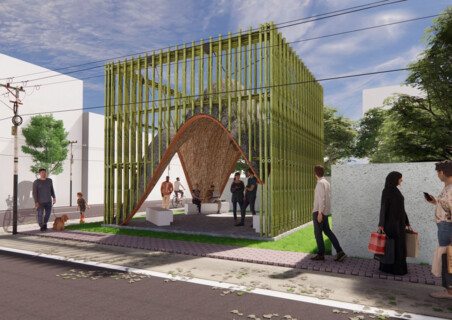- wa-ID
- wa-2030255
- Tag der Veröffentlichung
- 16.11.2020
- Aktualisiert am
- 21.04.2021
- Verfahrensart
- Offener Wettbewerb
- Zulassungsbereich
-
Andere
- Teilnehmer
- Architekt*innen, Designer*innen etc
- Auslober
- IDHA LABS
- Bewerbungsschluss
- 06.12.2020
- Abgabetermin
- 27.12.2020
- Bekanntgabe
- 28.02.2021
Verfahrensart
Offener Ideenwettbewerb
Wettbewerbsaufgabe
Bei dem Wettbewerb geht es darum, einen Pavillon zu entwerfen - einen Gemeinschaftsraum, der in den sich wandelnden städtischen Umgebungen von allen gleichermaßen genutzt werden kann. Er könnte ein neues Refugium sein, eine inspirierende und beruhigende Auszeit!
Der Pavillon kann ein Ort sein, der für verschiedene urbane Aktivitäten genutzt werden kann; er kann ein Ort zum Entspannen und zum Spazierengehen werden, ein kleiner Gemeinschaftsraum zum Versammeln, Diskutieren und sogar zum Herumlungern. Der Pavillon soll aus nachhaltigem Baumaterial wie Bambus gebaut werden.
NODE - Der Pavillon, ein Gemeinschaftsraum, wird von allen gleichberechtigt in den sich wandelnden urbanen Räumen genutzt. Er ist ein neues Refugium, eine inspirierende und beruhigende Auszeit! Node kann je nach Kontext interpretiert werden, er kann ein Ort sein, der für verschiedene urbane Aktivitäten genutzt wird; er kann ein Ort zum Entspannen und Flanieren sein, ein kleiner Gemeinschaftsraum, um sich zu versammeln, zu diskutieren und sogar zu verweilen. Eine Pause in der chaotischen Stadt oder einfach ein Treffpunkt für die Morgen- und Abendstunden. Der Knotenpunkt kann sich in den Kontext einfügen oder herausstechen, aber die primäre Funktion sollte an einen öffentlichen Raum erinnern. Der NODE sollte einen Sinn für Gemeinschaft haben und einfach zu realisieren sein. Könnte er partizipatorisch im Prozess sein?
Ein weiteres Ziel dieser Design Challenge ist es, das Bewusstsein für Bambus als nachhaltiges Baumaterial zu schärfen. Die Teilnehmer müssen Bambus als primäres Material bei der Neugestaltung des öffentlichen Raums einsetzen, indem sie eine Verbindung mit dem Ort und seiner Umgebung schaffen. Auf der einen Seite wird das Ephemere und auf der anderen Seite das Gedenken an einen Gemeinschaftsgeist angeregt.
Der Knotenpunkt soll die Hoffnung und den Traum der Menschen von einer nachhaltigen und umweltfreundlichen Zukunft symbolisieren - und eine lebenswertere Umgebung bieten. Im Geiste ist es das Zurückgeben der Gemeinschaftsräume an unsere nächste Generation, wobei nachhaltige Baumaterialien wie Bambus zum Einsatz kommen, die die innige Beziehung zwischen Mensch und Natur hervorheben. Die Form, die Verarbeitung und die Details gehen davon aus, dass den Strukturen aus Bambus ein gewisses Leben innewohnt.
Das vorgeschlagene Design würde jedoch die zukünftigen Generationen der Gemeinde dazu inspirieren, Architektur aus Bambus als ein wiederkehrendes Phänomen ökologischer Konzeption zu gestalten.
Competition assignment
The competition is to design a pavilion - a community space, that can be shared equally by one and all in the transforming urban settings. It could be a new refuge, an inspiring and calming breather!
The pavilion can be a place catering to various urban activities; where it can become a place to relax and to wander in, a small community space for to gather, discuss and even loiter. to be built using sustainable building material like bamboo.
NODE - The pavilion, a community space, is shared equally by one and all in the transforming urban settings. It is a new refuge, an inspiring and calming breather! Node can be interpreted based on its context, it can be a place catering to various urban activities; where it can become a place to relax and to wander in, a small community space for to gather, discuss and even loiter. A pause in the chaotic city or simply becoming a hangout/gathering place during in the mornings and the evenings. Node can blend in with the context or stand out, but the primary function should be evocative of being a public space. It having a sense of community, the NODE should be easy to realise. Could it be participatory in process?
Another objective of this design challenge is to raise the awareness of bamboo as a sustainable building material. Participants have to leverage bamboo as the primary material in reconfiguring the public space, by creating a communion with the site and its surroundings. On one hand, it prompts the ephemeral and on the other, the memorial of a community spirit.
The Node should symbolise the human hope and dream of the sustainable and eco-friendly future - offering a more habitable environment. and In spirit, it is the giving back of the community spaces to our next generation, leveraging sustainable building materials like bamboo highlighting the intimate relationship between human beings and nature. Its form, workmanship and details are assuming that there is a certain life to the structures in bamboo.
However, the proposed design would inspire the future generations of the community to make architecture of bamboo as a reoccurring phenomenon of ecological conception.
Weitere Informationen zu den Gewinnern finden Sie unter /
More information about the winners can be found at:
idhalabs.com/node-bamboo-pavilion
Offener Ideenwettbewerb
Wettbewerbsaufgabe
Bei dem Wettbewerb geht es darum, einen Pavillon zu entwerfen - einen Gemeinschaftsraum, der in den sich wandelnden städtischen Umgebungen von allen gleichermaßen genutzt werden kann. Er könnte ein neues Refugium sein, eine inspirierende und beruhigende Auszeit!
Der Pavillon kann ein Ort sein, der für verschiedene urbane Aktivitäten genutzt werden kann; er kann ein Ort zum Entspannen und zum Spazierengehen werden, ein kleiner Gemeinschaftsraum zum Versammeln, Diskutieren und sogar zum Herumlungern. Der Pavillon soll aus nachhaltigem Baumaterial wie Bambus gebaut werden.
NODE - Der Pavillon, ein Gemeinschaftsraum, wird von allen gleichberechtigt in den sich wandelnden urbanen Räumen genutzt. Er ist ein neues Refugium, eine inspirierende und beruhigende Auszeit! Node kann je nach Kontext interpretiert werden, er kann ein Ort sein, der für verschiedene urbane Aktivitäten genutzt wird; er kann ein Ort zum Entspannen und Flanieren sein, ein kleiner Gemeinschaftsraum, um sich zu versammeln, zu diskutieren und sogar zu verweilen. Eine Pause in der chaotischen Stadt oder einfach ein Treffpunkt für die Morgen- und Abendstunden. Der Knotenpunkt kann sich in den Kontext einfügen oder herausstechen, aber die primäre Funktion sollte an einen öffentlichen Raum erinnern. Der NODE sollte einen Sinn für Gemeinschaft haben und einfach zu realisieren sein. Könnte er partizipatorisch im Prozess sein?
Ein weiteres Ziel dieser Design Challenge ist es, das Bewusstsein für Bambus als nachhaltiges Baumaterial zu schärfen. Die Teilnehmer müssen Bambus als primäres Material bei der Neugestaltung des öffentlichen Raums einsetzen, indem sie eine Verbindung mit dem Ort und seiner Umgebung schaffen. Auf der einen Seite wird das Ephemere und auf der anderen Seite das Gedenken an einen Gemeinschaftsgeist angeregt.
Der Knotenpunkt soll die Hoffnung und den Traum der Menschen von einer nachhaltigen und umweltfreundlichen Zukunft symbolisieren - und eine lebenswertere Umgebung bieten. Im Geiste ist es das Zurückgeben der Gemeinschaftsräume an unsere nächste Generation, wobei nachhaltige Baumaterialien wie Bambus zum Einsatz kommen, die die innige Beziehung zwischen Mensch und Natur hervorheben. Die Form, die Verarbeitung und die Details gehen davon aus, dass den Strukturen aus Bambus ein gewisses Leben innewohnt.
Das vorgeschlagene Design würde jedoch die zukünftigen Generationen der Gemeinde dazu inspirieren, Architektur aus Bambus als ein wiederkehrendes Phänomen ökologischer Konzeption zu gestalten.
Competition assignment
The competition is to design a pavilion - a community space, that can be shared equally by one and all in the transforming urban settings. It could be a new refuge, an inspiring and calming breather!
The pavilion can be a place catering to various urban activities; where it can become a place to relax and to wander in, a small community space for to gather, discuss and even loiter. to be built using sustainable building material like bamboo.
NODE - The pavilion, a community space, is shared equally by one and all in the transforming urban settings. It is a new refuge, an inspiring and calming breather! Node can be interpreted based on its context, it can be a place catering to various urban activities; where it can become a place to relax and to wander in, a small community space for to gather, discuss and even loiter. A pause in the chaotic city or simply becoming a hangout/gathering place during in the mornings and the evenings. Node can blend in with the context or stand out, but the primary function should be evocative of being a public space. It having a sense of community, the NODE should be easy to realise. Could it be participatory in process?
Another objective of this design challenge is to raise the awareness of bamboo as a sustainable building material. Participants have to leverage bamboo as the primary material in reconfiguring the public space, by creating a communion with the site and its surroundings. On one hand, it prompts the ephemeral and on the other, the memorial of a community spirit.
The Node should symbolise the human hope and dream of the sustainable and eco-friendly future - offering a more habitable environment. and In spirit, it is the giving back of the community spaces to our next generation, leveraging sustainable building materials like bamboo highlighting the intimate relationship between human beings and nature. Its form, workmanship and details are assuming that there is a certain life to the structures in bamboo.
However, the proposed design would inspire the future generations of the community to make architecture of bamboo as a reoccurring phenomenon of ecological conception.
Weitere Informationen zu den Gewinnern finden Sie unter /
More information about the winners can be found at:
idhalabs.com/node-bamboo-pavilion
Pavilion Design Challenge 2020
Organizers
IDHA LABS
idhalabs.com
Queries and Questions
All the queries related to the competition can be mailed to us at team@idhalabs.com with ‚query - Bamboo Pavilion Challenge‘ as the subject.
Competition Assignment
The competition is to design a pavilion - a community space, that can be shared equally by one and all in the transforming urban settings. It could be a new refuge, an inspiring and calming breather!
The pavilion can be a place catering to various urban activities; where it can become a place to relax and to wander in, a small community space for to gather, discuss and even loiter. to be built using sustainable building material like bamboo.
NODE - The pavilion, a community space, is shared equally by one and all in the transforming urban settings. It is a new refuge, an inspiring and calming breather! Node can be interpreted based on its context, it can be a place catering to various urban activities; where it can become a place to relax and to wander in, a small community space for to gather, discuss and even loiter. A pause in the chaotic city or simply becoming a hangout/gathering place during in the mornings and the evenings. Node can blend in with the context or stand out, but the primary function should be evocative of being a public space. It having a sense of community, the NODE should be easy to realise. Could it be participatory in process?
Another objective of this design challenge is to raise the awareness of bamboo as a sustainable building material. Participants have to leverage bamboo as the primary material in reconfiguring the public space, by creating a communion with the site and its surroundings. On one hand, it prompts the ephemeral and on the other, the memorial of a community spirit.
The Node should symbolise the human hope and dream of the sustainable and eco-friendly future - offering a more habitable environment. and In spirit, it is the giving back of the community spaces to our next generation, leveraging sustainable building materials like bamboo highlighting the intimate relationship between human beings and nature. Its form, workmanship and details are assuming that there is a certain life to the structures in bamboo.
However, the proposed design would inspire the future generations of the community to make architecture of bamboo as a reoccurring phenomenon of ecological conception.
Participants
The Pavilion Design Competition invites all architects, designers and allied specializations, both student and professional to participate in the competition.
Schedule
Early Bird Registrations: 30th October 2020 - 22nd November 2020
Regular Registrations: 23rd November 2020 - 06th December 2020
Expert Session on Bamboo Architecture: 21st November 2020 onwards
Submission Deadline: 11.59 PM IST on 27th December 2020
Results Announcement: 24th January 2021
Jury
Prof. Miki Desai, Architect I Researcher I Author, Co-founder of Archicrafts
Ar.Neelam Manjunath, Architect I Founder of CGBMT & Manasaram Architects
Nripal Adhikari, Designer I Researcher, Founder of Abari
Ar.Richard Belho, Architect I Researcher, Founder of Zynorique
Prizes
Professionals Category: INR 30000 + Publication + The Best Design built by ABARI + Certificate
Students Category: INR 20000 + Publication + Internship Opportunity + Certificate
Honourable Mentions: Winners and honourable mentions will be published on IDHA Labs and journal partners‘ websites / journals
More information and details at
idhalabs.com/node-bamboo-pavilion
Organizers
IDHA LABS
idhalabs.com
Queries and Questions
All the queries related to the competition can be mailed to us at team@idhalabs.com with ‚query - Bamboo Pavilion Challenge‘ as the subject.
Competition Assignment
The competition is to design a pavilion - a community space, that can be shared equally by one and all in the transforming urban settings. It could be a new refuge, an inspiring and calming breather!
The pavilion can be a place catering to various urban activities; where it can become a place to relax and to wander in, a small community space for to gather, discuss and even loiter. to be built using sustainable building material like bamboo.
NODE - The pavilion, a community space, is shared equally by one and all in the transforming urban settings. It is a new refuge, an inspiring and calming breather! Node can be interpreted based on its context, it can be a place catering to various urban activities; where it can become a place to relax and to wander in, a small community space for to gather, discuss and even loiter. A pause in the chaotic city or simply becoming a hangout/gathering place during in the mornings and the evenings. Node can blend in with the context or stand out, but the primary function should be evocative of being a public space. It having a sense of community, the NODE should be easy to realise. Could it be participatory in process?
Another objective of this design challenge is to raise the awareness of bamboo as a sustainable building material. Participants have to leverage bamboo as the primary material in reconfiguring the public space, by creating a communion with the site and its surroundings. On one hand, it prompts the ephemeral and on the other, the memorial of a community spirit.
The Node should symbolise the human hope and dream of the sustainable and eco-friendly future - offering a more habitable environment. and In spirit, it is the giving back of the community spaces to our next generation, leveraging sustainable building materials like bamboo highlighting the intimate relationship between human beings and nature. Its form, workmanship and details are assuming that there is a certain life to the structures in bamboo.
However, the proposed design would inspire the future generations of the community to make architecture of bamboo as a reoccurring phenomenon of ecological conception.
Participants
The Pavilion Design Competition invites all architects, designers and allied specializations, both student and professional to participate in the competition.
Schedule
Early Bird Registrations: 30th October 2020 - 22nd November 2020
Regular Registrations: 23rd November 2020 - 06th December 2020
Expert Session on Bamboo Architecture: 21st November 2020 onwards
Submission Deadline: 11.59 PM IST on 27th December 2020
Results Announcement: 24th January 2021
Jury
Prof. Miki Desai, Architect I Researcher I Author, Co-founder of Archicrafts
Ar.Neelam Manjunath, Architect I Founder of CGBMT & Manasaram Architects
Nripal Adhikari, Designer I Researcher, Founder of Abari
Ar.Richard Belho, Architect I Researcher, Founder of Zynorique
Prizes
Professionals Category: INR 30000 + Publication + The Best Design built by ABARI + Certificate
Students Category: INR 20000 + Publication + Internship Opportunity + Certificate
Honourable Mentions: Winners and honourable mentions will be published on IDHA Labs and journal partners‘ websites / journals
More information and details at
idhalabs.com/node-bamboo-pavilion




















